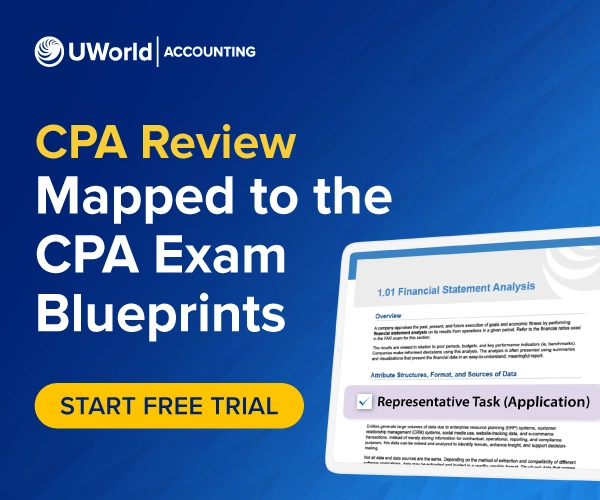Choosing the right CPA exam order isn't just about convenience; it's about giving yourself the best shot at passing. Each section comes with a different level of difficulty and content overlap. Starting with the right one helps build momentum, boost your confidence, and make your CPA journey smoother.
What the CPA Exam Looks Like in 2025-2026
Before you decide where to start, it helps to know how the CPA exam is laid out in its current format. As of 2024, the exam follows a Core + Discipline model that gives candidates some flexibility based on their strengths and goals.
You'll need to pass three Core sections required for all candidates, plus one Discipline section you choose.
Core Sections (mandatory):
- AUD – Auditing and Attestation
- FAR – Financial Accounting and Reporting
- REG – Regulation
Discipline Sections (choose one):
- BAR – Business Analysis and Reporting
- ISC – Information Systems and Controls
- TCP – Tax Compliance and Planning
Best Order to Take CPA Exams for Maximum Success
One of the most recommended CPA exam sequences for independent candidates is:
FAR → AUD → REG → Discipline
This path builds a strong foundation, minimizes content fatigue, and mirrors how many top performers structure their CPA exam roadmap.
Why Start With FAR?
FAR is the most comprehensive and technical exam in the CPA series. It covers the core principles of financial reporting, which reappear in other sections, especially AUD and BAR.
- Lays the groundwork for key accounting concepts
- Frequently considered the most difficult exam
- Concepts from FAR show up across the board, especially in CPA Review materials
- Tackling it early helps you prepare mentally and gives flexibility if a retake is needed
Choosing FAR first aligns with many CPA courses that suggest starting with your toughest exam when motivation is high.
Tackle AUD While FAR Is Still Fresh
AUD builds directly on topics from FAR, like financial reporting and internal control systems. While the questions may appear straightforward, they often require judgment and interpretation.
- Builds on FAR knowledge, especially around auditing and reporting
- Concept-heavy and best attempted when accounting standards are still fresh
- Considered tricky due to its analytical nature
- CPA Qbanks often recommend pairing AUD study closely with FAR to improve retention
- This is where structured CPA prep helps; courses that link FAR and AUD content can boost understanding.
Then Take REG
REG focuses on federal taxation and business law. It's ideal to take after AUD because it shifts from reporting and analysis to rule-based content.
- Easier to grasp for candidates with tax work experience or recent coursework
- Emphasizes memorization and application of laws and ethics
- A logical break from FAR/AUD while still keeping your study rhythm
If you've used a CPA Review program that offers adaptive learning, this is often where you'll start seeing faster progress.
Wrap Up with the Right Discipline for Your Goals
The final exam should be the Discipline section of your choice: ISC, TCP, or BAR, based on your interests or career goals.
- Take this last to benefit from the knowledge gained in the Core exams
- Ideal if you weren't sure which path to pick early on
- Match it to your experience: ISC for tech-savvy roles, TCP for tax professionals, BAR for those headed into advisory
Most CPA courses allow you to switch disciplines mid-way, giving you time to make an informed choice.
Custom CPA Exam Roadmaps for Different Backgrounds
While there's a widely recommended CPA exam sequence, best sequence to take cpa success also depends on your personal background, career path, and confidence with key topics. Here are a few adjusted CPA exam roadmaps to help you succeed based on where you're starting from:
If You're a Recent Accounting Graduate
Recommended Order: FAR → AUD → REG → ISC
Recent grads usually have a strong foundation in financial accounting and auditing, making FAR a smart first step. Follow it with AUD, since there is significant content overlap and both rely on current academic knowledge. Next, move to REG and finish with a discipline like ISC, once you have a clearer idea of your long-term career goals. Many CPA courses suggest this route to maintain familiarity with exam topics early on.
If You're Working Full-Time in Tax
Recommended Order: REG → TCP → FAR → AUD
If you are already working in tax, start with REG to leverage your day-to-day knowledge. It's a good way to gain an early win and build confidence. Next, go for TCP, the discipline that matches your expertise, before moving to FAR and AUD. These sections require heavier study, so it's helpful to complete them once you have exam momentum. This CPA exam sequence aligns well with many tax professionals using CPA review programs customized for their niche.
If You're Career-Switching or Have Been Out of School:
Recommended Order: AUD → FAR → REG → BAR
For candidates returning to the profession or changing careers, AUD is a good starting point. It's more conceptual and less calculation-heavy, which makes it easier to re-engage with study. Once you're more comfortable, move into FAR, then REG, and close with a discipline like BAR that focuses on business analysis and reporting. This gradual increase in complexity helps many professionals ease back into academic study, especially when supported by CPA Qbank tools for regular practice.
Challenges and Advantages of Each CPA Exam Section
Each CPA section comes with its own strengths and sticking points. Understanding what makes each exam easier or harder can help you build best sequence to take CPA success, playing to your strengths and avoids burnout.
| Section | Advantages | Cons |
|---|---|---|
| FAR | Builds a strong foundation and aligns well with college-level accounting content | Most technical and time-consuming, requires the longest study time |
| AUD | Conceptual and logic-based, with overlap from FAR | Subjective scoring, difficult to master through memorization |
| REG | Practical and rules-based, especially useful for tax professionals | Heavy memorization; law content can feel dense or unrelated |
| ISC | Focused on systems, controls, and technology with less memorization | Newer section with limited review content; may feel unfamiliar |
| TCP | Deep tax knowledge makes it ideal for candidates in compliance roles | Niche topics; may not apply to candidates without direct tax experience |
| BAR | Highly analytical and excellent for careers in advisory or business analysis | Requires strong reporting and data interpretation skills |
Why UWorld Works for Every CPA Exam Order
No matter which CPA exam you choose to start with, UWorld's CPA Review tools are designed to support your success at every stage. Whether you're tackling FAR first or saving REG for later, your prep experience stays consistent and high-quality.
Here's how UWorld helps you stay on track:
- Adaptive Study Planner: Adjusts your schedule and strategy to match your exam sequence and pace
- Roger-style Video Lectures: Engaging, high-energy lessons tailored to how each section is best learned
- Smart QBank with Visual Explanations: Learn through practice with detailed solutions that make complex topics clear
- Section-Specific Flashcards & Mock Exams: Reinforce key terms, formulas, and test-day strategy for every exam section
- CPA Evolution-Aligned Content: All Core and Discipline sections are updated to match the latest CPA Exam format
Final Thoughts
There is no one-size-fits-all CPA exam sequence. The best order depends on your background, strengths, and long-term goals. Whether you begin with your strongest subject or a comprehensive section like FAR, starting with the right exam can help you build confidence and maintain momentum. Take time to understand the structure of each section and create a study plan that fits your lifestyle. With a focused strategy and support from a trusted resource like UWorld CPA Review, you can move through each exam with clarity and purpose, no matter the order you choose.
Frequently Asked Questions [FAQs]
Yes, many candidates find that starting with FAR, followed by AUD, then REG, and finishing with a discipline section is the most effective sequence. This order builds a strong foundation and keeps topic overlap fresh between sections.
If you’re working in tax, starting with REG is a smart choice. It allows you to use your day-to-day experience to your advantage and build early confidence before moving on to more technical sections like FAR and AUD.
No, the exam order doesn’t directly affect your score. However, choosing the right sequence based on your strengths can improve your confidence and momentum, which may increase your chances of passing each section on the first try.








